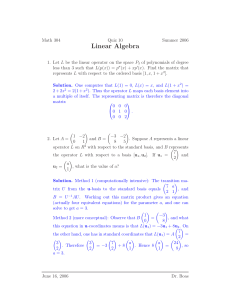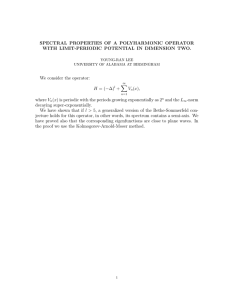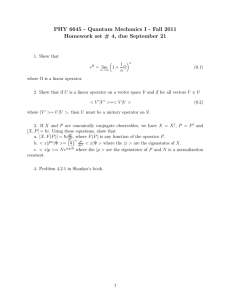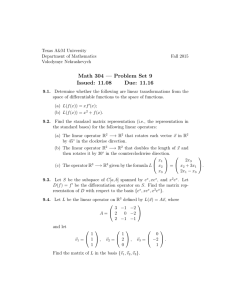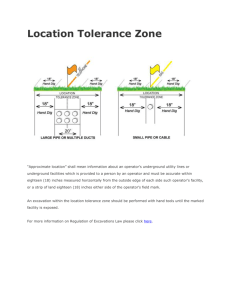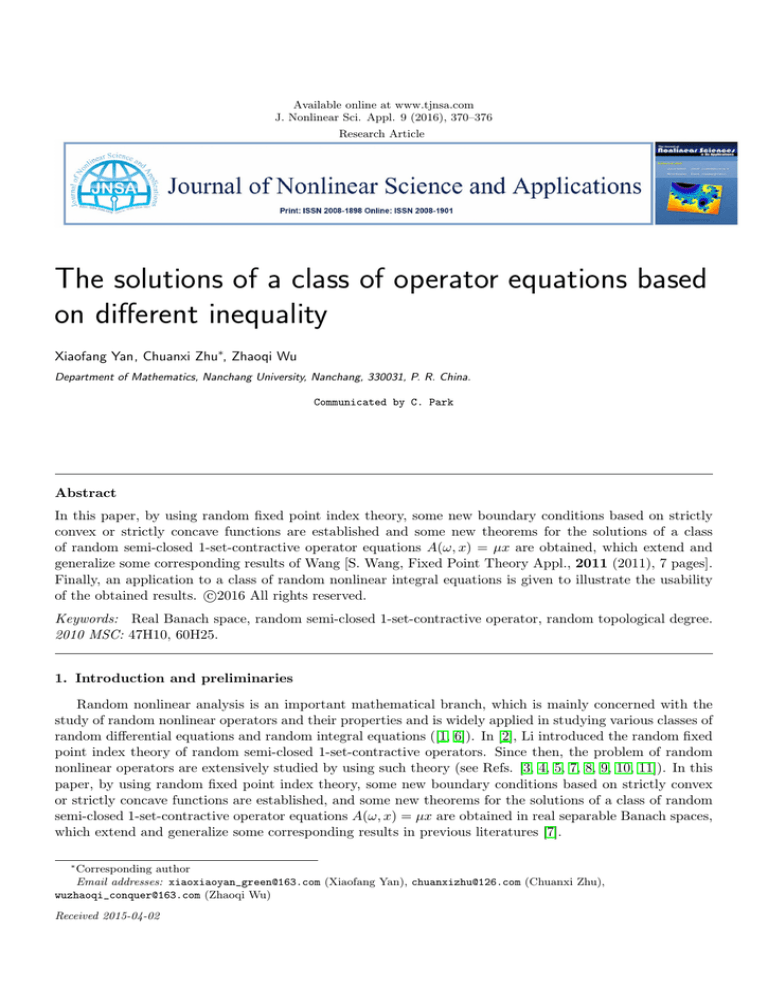
Available online at www.tjnsa.com
J. Nonlinear Sci. Appl. 9 (2016), 370–376
Research Article
The solutions of a class of operator equations based
on different inequality
Xiaofang Yan, Chuanxi Zhu∗, Zhaoqi Wu
Department of Mathematics, Nanchang University, Nanchang, 330031, P. R. China.
Communicated by C. Park
Abstract
In this paper, by using random fixed point index theory, some new boundary conditions based on strictly
convex or strictly concave functions are established and some new theorems for the solutions of a class
of random semi-closed 1-set-contractive operator equations A(ω, x) = µx are obtained, which extend and
generalize some corresponding results of Wang [S. Wang, Fixed Point Theory Appl., 2011 (2011), 7 pages].
Finally, an application to a class of random nonlinear integral equations is given to illustrate the usability
c
of the obtained results. 2016
All rights reserved.
Keywords: Real Banach space, random semi-closed 1-set-contractive operator, random topological degree.
2010 MSC: 47H10, 60H25.
1. Introduction and preliminaries
Random nonlinear analysis is an important mathematical branch, which is mainly concerned with the
study of random nonlinear operators and their properties and is widely applied in studying various classes of
random differential equations and random integral equations ([1, 6]). In [2], Li introduced the random fixed
point index theory of random semi-closed 1-set-contractive operators. Since then, the problem of random
nonlinear operators are extensively studied by using such theory (see Refs. [3, 4, 5, 7, 8, 9, 10, 11]). In this
paper, by using random fixed point index theory, some new boundary conditions based on strictly convex
or strictly concave functions are established, and some new theorems for the solutions of a class of random
semi-closed 1-set-contractive operator equations A(ω, x) = µx are obtained in real separable Banach spaces,
which extend and generalize some corresponding results in previous literatures [7].
∗
Corresponding author
Email addresses: xiaoxiaoyan_green@163.com (Xiaofang Yan), chuanxizhu@126.com (Chuanxi Zhu),
wuzhaoqi_conquer@163.com (Zhaoqi Wu)
Received 2015-04-02
Xiaofang Yan, Chuanxi Zhu, Zhaoqi Wu, J. Nonlinear Sci. Appl. 9 (2016), 370–376
371
In this paper, let (Ω, U, γ) be a complete probability measure space, γ(Ω) = 1. Let E be a separable real
Banach space, (E, B) be a measurable space, where B denotes the σ-algebra generated by all the subsets of
E, and D be a bounded open subset in E, ∂D the boundary of D in E.
Definition 1.1 ([2]). A random continuous and bounded operator A : Ω × D → E is said to be a Evalued random semi-closed 1-set-contractive operator, if for almost all ω ∈ Ω , A(ω, ·) is a semi-closed
1-set-contractive operator in D, (if I − A is a closed operator and for every ω ∈ Ω, α(A(ω, D)) ≤ α(D), see
[5]), and for every x ∈ D, A(·, x) : Ω → E is an E-valued random operator.
Let D be a nonempty subset of R. If ϕ : D → R is a real function such that
ϕ[tx + (1 − t)y] < tϕ(x) + (1 − t)ϕ(y)
for all x, y ∈ D, x 6= y, t ∈ (0, 1), then ϕ is called a strictly convex function onD. If ϕ : D → R is a real
function such that
ϕ[tx + (1 − t)y] > tϕ(x) + (1 − t)ϕ(y)
for all x, y ∈ D, x 6= y, t ∈ (0, 1), then ϕ is called a strictly concave function on D.
Lemma 1.2 ([2]). Let E be a separable real Banach space, X be a closed convex subset of E, D be a bounded
open subset in X, and θ ∈ D. Suppose that A : Ω × D → X is a random semi-closed 1-set-contractive
operator, such that
A(ω, x) 6= αx
for all (ω, x) ∈ Ω × ∂D, and α > µ, where µ ≥ 1. Then random operator equations A(ω, x) = µx has a
random solution in D.
2. Main results
Theorem 2.1. Let E be a separable real Banach space, X be a closed convex subset of E, D be a bounded
open subset in X and θ ∈ D. Suppose that A : Ω × D → X is a random semi-closed 1-set-contractive
operator and θ ∈
/ A(ω, ∂D), ∀ω ∈ Ω. Moreover, if there exist a strictly convex function ϕ : R+ −→ R+ with
ϕ(0) = 0 and a real function φ : R+ −→ R+ with φ(t) ≥ 1 for all t > 1, such that
λ1 ϕ(k A(ω, x) − µxk) ≥ λ2 ϕ(kA(ω, x)k)φ(kA(ω, x) + µxk · kµxk−1 ) − λ1 ϕ(kµxk)
(2.1)
for all (ω, x) ∈ Ω × ∂D, where 0 < λ1 ≤ λ2 . Then random operator equations A(ω, x) = µx(µ ≥ 1) has a
random solution in D.
Proof. By Lemma 1.2, we only need to prove that A(ω, x) 6= αx, ∀(ω, x) ∈ Ω × ∂D, α > µ, where µ ≥ 1.
Suppose this is not true. Then there exists (ω0 , x0 ) ∈ Ω × ∂D and α0 > µ ≥ 1, such that A(ω0 , x0 ) = α0 x0 ,
i.e., x0 = α0−1 A(ω0 , x0 ). From (2.1),we have
λ1 ϕ(kA(ω0 , x0 ) − α0−1 µA(ω0 , x0 )k) ≥λ2 ϕ(A(ω0 , x0 )k)φ(kA(ω0 , x0 ) + α0−1 µkA(ω0 , x0 )k
· kα0−1 µA(ω0 , x0 )k−1 ) − λ1 ϕ(kα0−1 µA(ω0 , x0 k),
which implies that
λ1 ϕ((1 − α0−1 µ)kA(ω0 , x0 )k) + λ1 ϕ(kα0−1 µA(ω0 , x0 )k)
≥λ2 ϕ(k A(ω0 , x0 )k) · φ[(1 + α0−1 µ) · kA(ω0 , x0 )k · α0 µ−1 kA(ω0 , x0 )k−1 ]
=λ2 ϕ(k A(ω0 , x0 )k) · φ(α0 µ
−1
+ 1).
(2.2)
Xiaofang Yan, Chuanxi Zhu, Zhaoqi Wu, J. Nonlinear Sci. Appl. 9 (2016), 370–376
372
By the strict convexity of ϕ and ϕ(0) = 0, A(ω0 , x0 ) 6= θ, we obtain
λ1 ϕ[(1 − α0−1 µ)kA(ω0 , x0 )k + α0−1 µkθk] + λ1 ϕ(α0−1 µkA(ω0 , x0 )k) + (1 − α0−1 µ)kθk)
<(1 − α0−1 µ)λ1 ϕ(kA(ω0 , x0 )k) + α0−1 µλ1 ϕ(kθk) + α0−1 µλ1 ϕ(kA(ω0 , x0 )k) + (1 − α0−1 )µλ1 ϕ(kθk)
(2.3)
=λ1 ϕ(kA(ω0 , x0 )k).
It is easy to see from (2.2)and(2.3),
λ2 ϕ(kA(ω0 , x0 )k)φ[(α0 µ−1 + 1)] < λ1 ϕ(kA(ω0 , x0 )k).
However, since α0 > µ ≥ 1, we have 1 + α0 µ−1 > 1, and thus φ(α0 µ−1 + 1) ≥ 1. Noting that 0 < λ1 ≤ λ2 , we
have λ2 ϕ(kA(ω0 , x0 )k)φ[(α0−1 µ + 1)] ≥ λ1 ϕ(kA(ω0 , x0 )k), which is a contradiction. It follows from Lemma
1.2 that random operator equations A(ω, x) = µx(µ ≥ 1) has a random solution in D.
Remark 2.2. If there exist a convex function ϕ : R+ → R+ , with ϕ(0) = 0 and a real function φ : R+ → R+ ,
with φ(t) > 1, for all t > 1 satisfying (2.1), the conclusion of Theorem2.1 also hold.
Corollary 2.3. Let E be a separable real Banach space, X be a closed convex subset of E, D be a bounded
open subset in X and θ ∈ D. Suppose that A : Ω × D → X is a random semi-closed 1-set-contractive
operator and θ ∈
/ A(ω, ∂D), ∀ω ∈ Ω. Moreover, if there exist α ∈ (−∞, 0) ∪ (1, +∞) and β ≥ 0, such that
λ1 kA(ω, x) − µxkα kµxkβ ≥ λ2 kA(ω, x)kα kA(ω, x) + µxkβ − λ1 kµxkα+β
for all (ω, x) ∈ Ω × ∂D, where 0 < λ1 ≤ λ2 . Then random operator equations A(ω, x) = µx(µ ≥ 1) has a
random solution in D.
Proof. Let ϕ(t) = tα , φ(t) = tβ . Then ϕ(t) is a strictly convex function with ϕ(0) = 0 and φ(t) ≥ 1 for all
t > 1 . Therefore, by Theorem 2.1, the conclusions follows immediately.
Remark 2.4. Letting β = 0, α = 2 , λ1 = λ2 = 1 and µ = 1 in Corollary2.3 , A(ω0 , ·) = A and A
is completely continuous operator. Thus Corollary 2.3 becomes the famous Altman, s theorem. Thus,
Corollary 2.3 generalizes Altman, s theorem.
Theorem 2.5. Let E be a separable real Banach space, X be a closed convex subset of E, D be a bounded
open subset in X, and θ ∈ D. Suppose that A : Ω × D → X is a random semi-closed 1-set-contractive
operator and θ ∈
/ A(ω, ∂D), ∀ω ∈ Ω. Moreover, if there exist a strictly concave function ϕ : R+ −→ R+ with
ϕ(0) = 0 and a real function φ : R+ −→ R+ with φ(t) ≤ 1 for all t > 1, such that
λ1 ϕ(k A(ω, x) − µxk) ≤ λ2 ϕ(kA(ω, x) k)φ(kA(ω, x) + µxk · kµxk−1 ) − λ1 ϕ(kµxk)
(2.4)
for all (ω, x) ∈ Ω × ∂D, where λ1 ≥ λ2 > 0. Then random operator equations A(ω, x) = µx(µ ≥ 1) has a
random solution in D.
Proof. By Lemma 1.2, we only need to prove that A(ω, x) 6= αx, ∀(ω, x) ∈ Ω × ∂D, α > µ, where µ ≥ 1.
Suppose this is not true. Then there exist (ω0 , x0 ) ∈ Ω × ∂D and α0 > µ ≥ 1, such that A(ω0 , x0 ) = α0 x0 ,
i.e., x0 = α0−1 A(ω0 , x0 ). From (2.4), we have
λ1 ϕ(kA(ω0 , x0 ) − α0−1 µA(ω0 , x0 )k) ≤λ2 ϕ(kA(ω0 , x0 )k)φ(kA(ω0 , x0 ) + α0−1 µA(ω0 , x0 )k
· kα0−1 µA(ω0 , x0 )k−1 ) − λ1 ϕ(kα0−1 µA(ω0 , x0 k),
which implies that
λ1 ϕ[(1 − α0−1 µ)kA(ω0 , x0 )k] + λ1 ϕ[kα0−1 µA(ω0 , x0 )k]
≤λ2 ϕ(k A(ω0 , x0 )k) · φ[(1 + α0−1 µ) · kA(ω0 , x0 )k · α0 µ−1 kA(ω0 , x0 )k−1 ]
=λ2 ϕ(k A(ω0 , x0 )k) · φ(α0 µ
−1
+ 1).
(2.5)
Xiaofang Yan, Chuanxi Zhu, Zhaoqi Wu, J. Nonlinear Sci. Appl. 9 (2016), 370–376
373
By the strict concavity of ϕ and ϕ(0) = 0, we obtain
λ1 ϕ[(1 − α0−1 µ)kA(ω0 , x0 )k + α0−1 µkθk] + λ1 ϕ[α0−1 µkA(ω0 , x0 )k) + (1 − α0−1 µ)kθk]
>(1 − α0−1 µ)λ1 ϕ(kA(ω0 , x0 )k) + α0−1 µλ1 ϕ(kθk) + α0−1 µλ1 ϕ(kA(ω0 , x0 )k) + (1 − α0−1 µ)λ1 ϕ(kθk)
(2.6)
=λ1 ϕ(kA(ω0 , x0 )k).
It is easy to see from (2.5) and (2.6) that
λ2 ϕ(kA(ω0 , x0 )k)φ[(α0 µ−1 + 1)] > λ1 ϕ(kA(ω0 , x0 )k).
However, since α0 > µ ≥ 1, we have α0 µ−1 + 1 > 1 and thus φ(α0 µ−1 + 1) ≤ 1. Noting that λ1 ≥ λ2 > 0, we
have λ2 ϕ(kA(ω0 , x0 )k)φ[(α0−1 µ + 1)] ≤ λ1 ϕ(kA(ω0 , x0 )k), which is a contradiction. It follows from Lemma
1.2 that random operator equations A(ω, x) = µx(µ ≥ 1) has a random solution in D.
Remark 2.6. If there exist a concave function ϕ : R+ → R+ with ϕ(0) = 0 and a real function φ : R+ → R+ ,
with φ(t) < 1 for all t > 1 satisfying (2.4), the conclusion of Theorem 2.5 also hold.
Corollary 2.7. Let E be a separable real Banach space,X be a closed convex subset of E, D be a bounded
open subset in X and θ ∈ D. Suppose that A : Ω × D → X is a random semi-closed 1-set-contractive
operator and θ ∈
/ A(ω, ∂D), for all ω ∈ Ω, where λ1 ≥ λ2 > 0. Moreover, if there exist α ∈ (0, 1) and β ≤ 0,
such that
λ1 kA(ω, x) − µxkα kµxkβ ≤ λ2 kA(ω, x)kα kA(ω, x) + µxkβ − λ1 kµxkα+β
for all (ω, x) ∈ Ω × ∂D, λ1 ≥ λ2 > 0. Then random operator equations A(ω, x) = µx(µ ≥ 1) has a random
solution in D.
Proof. Let ϕ(t) = tα , φ(t) = tβ . Then ϕ(t) is a strictly convex function with φ(t) ≥ 1 for all t > 1 and
ϕ(0) = 0. Therefore, by Theorem 2.5, the conclusion follows immediately.
Theorem 2.8. Let E be a separable real Banach space, X be a closed convex subset of E, D be a bounded
open subset in X and θ ∈ D. Suppose that A : Ω × D → X is a random semi-closed 1-set-contractive
operator and θ ∈
/ A(ω, ∂D), ∀ω ∈ Ω. Moreover, if there exist a strictly convex function ϕ : R+ −→ R+ with
ϕ(0) = 0 and a real function φ : R+ −→ R+ with φ(t) ≥ 1 for all t > 1, such that
λ1 ϕ(k A(ω, x) − µxk) ≥ λ2 ϕ(kA(ω, x)k)φ(kA(ω, x)k · kµxk−1 ) − λ1 ϕ(kµxk)
(2.7)
for all (ω, x) ∈ Ω × ∂D, where λ2 ≥ λ1 > 0. Then random operator equations A(ω, x) = µx(µ ≥ 1) has a
random solution in D.
Proof. By Lemma 1.2, we only need to prove that A(ω, x) =
6 αx, ∀(ω, x) ∈ Ω × ∂D, α > µ ≥ 1. Suppose
this is not true. Then there exists (ω0 , x0 ) ∈ Ω × ∂D and α0 > µ ≥ 1, such that A(ω0 , x0 ) = α0 x0 , i.e.,
x0 = α0−1 A(ω0 , x0 ). From (2.7), we have
λ1 ϕ(kA(ω0 , x0 ) − α0−1 µA(ω0 , x0 )k) ≥λ2 ϕ(kA(ω0 , x0 )k)φ(kA(ω0 , x0 )k · kα0−1 µA(ω0 , x0 )k−1 )
− λ1 ϕ(kα0−1 µA(ω0 , x0 )k),
which implies that
λ1 ϕ[(1 − α0−1 µ)kA(ω0 , x0 )k] + λ1 ϕ[kα0−1 µA(ω0 , x0 )k] ≥ λ2 ϕ(A(ω0 , x0 )k) · φ(µ−1 α0 ).
(2.8)
By the strict convexity of ϕ and ϕ(0) = 0, we obtain
λ1 ϕ[(1 − α0−1 µ)kA(ω0 , x0 )k + α0−1 µkθk] + λ1 ϕ[α0−1 µkA(ω0 , x0 )k] + (1 − α0−1 µ)kθk)
<λ1 (1 − α0−1 µ)ϕ(kA(ω0 , x0 )k) + λ1 α0−1 µϕ(kθk) + λ1 α0−1 µϕ(kA(ω0 , x0 )k) + λ1 (1 − α0−1 µ)ϕ(kθk)
=λ1 ϕ(kA(ω0 , x0 )k).
(2.9)
Xiaofang Yan, Chuanxi Zhu, Zhaoqi Wu, J. Nonlinear Sci. Appl. 9 (2016), 370–376
374
It is easy to see from (2.8) and (2.9) that
λ2 ϕ(kA(ω0 , x0 )k)φ(α0 µ−1 ) < λ1 ϕ(kA(ω0 , x0 )k).
However, since α0 > µ ≥ 1, we have α0 µ−1 ≥ 1, and thus φ(α0 µ−1 ) > 1. Noting that λ2 ≥ λ1 > 0, we have
λ2 ϕ(kA(ω0 , x0 )k)φ(µ−1 α0 ) ≥ λ1 ϕ(kA(ω0 , x0 )k), which is a contradiction. Therefore, it follows from Lemma
1.2 that random operator equations A(ω, x) = µx(µ ≥ 1) has a random solution in D.
Remark 2.9. If there exist a convex function ϕ : R+ → R+ with ϕ(0) = 0 and a real function φ : R+ → R+
with φ(t) > 1 for all t > 1 satisfying (2.7), the conclusion of Theorem 2.8 also hold.
Corollary 2.10. Let E be a separable real Banach space, X be a closed convex subset of E, D be a bounded
open subset in X and θ ∈ D. Suppose that A : Ω × D → X is a random semi-closed 1-set-contractive
operator and θ ∈
/ A(ω, ∂D), ∀ω ∈ Ω. Moreover, if there exist α ∈ (−∞, 0] ∪ [1, +∞) and β > 0, such that
λ1 kA(ω, x) − µxkα kµxkβ ≥ λ2 kA(ω, x)kα+β − λ1 kµxkα+β
for all (ω, x) ∈ Ω × ∂D, λ2 ≥ λ1 > 0. Then random operator equations A(ω, x) = µx(µ ≥ 1) has a random
solution in D.
Proof. Let ϕ(t) = tα , φ(t) = tβ . Then ϕ(t) is a convex function with ϕ(0) = 0 and φ(t) > 1 for all t > 1.
Therefore, by theorem 2.8, the conclusion follows immediately.
Remark 2.11. Letting µ = 1 and λ1 = λ2 = 1 in Corollary 2.10, A(ω, ·) = A, we can obtain Theorem 2.17
of [7].
Theorem 2.12. Let E be a separable real Banach space, X be a closed convex subset of E, D be a bounded
open subset in X, and θ ∈ D. Suppose that A : Ω × D → X is a random semi-closed 1-set-contractive
operator, and θ ∈
/ A(ω, ∂D), ∀ω ∈ Ω. Moreover, if there exist a strictly concave function ϕ : R+ −→ R+
with ϕ(0) = 0 and a real function φ : R+ −→ R+ with φ(t) ≤ 1 for all t > 1, such that
λ1 ϕ(k A(ω, x) − µxk) ≤ λ2 ϕ(kA(ω, x)k)φ(kA(ω, x)k · kµxk−1 ) − λ1 ϕ(kµxk)
(2.10)
for all (ω, x) ∈ Ω × ∂D, where 0 < λ2 ≤ λ1 . Then random operator equations A(ω, x) = µx has a random
solution in D.
Proof. By Lemma 1.2, we only need to prove that A(ω, x) =
6 αx, ∀(ω, x) ∈ Ω × ∂D, α > µ ≥ 1. Suppose
this is not true. Then there exist (ω0 , x0 ) ∈ Ω × ∂D and α0 > µ ≥ 1 such that A(ω0 , x0 ) = α0 x0 , i.e.,
x0 = α0−1 A(ω0 , x0 ). From (2.10), we have
λ1 ϕ(kA(ω0 , x0 ) − α0−1 µA(ω0 , x0 )k) ≤λ2 ϕ(kA(ω0 , x0 )k)φ(kA(ω0 , x0 )k · kα0−1 µA(ω0 , x0 )k−1 )
− λ1 ϕ(kα0−1 µA(ω0 , x0 )k),
which implies that
λ1 ϕ[(1 − α0−1 µ)kA(ω0 , x0 )k] + λ1 ϕ[kα0−1 µA(ω0 , x0 )k] ≤ λ2 ϕ(A(ω0 , x0 )k) · φ(µ−1 α0 ).
(2.11)
By the strict concavity of ϕ and ϕ(0) = 0, we obtain
λ1 ϕ[(1 − α0−1 µ)kA(ω0 , x0 )k + α0−1 µkθk] + λ1 ϕ[α0−1 µkA(ω0 , x0 )k] + (1 − α0−1 µ)kθk)
>λ1 (1 − α0−1 µ)ϕ(kA(ω0 , x0 )k) + λ1 α0−1 µϕ(kθk) + λ1 α0−1 µϕ(kA(ω0 , x0 )k) + λ1 (1 − α0−1 µ)ϕ(kθk)
=λ1 ϕ(kA(ω0 , x0 )k).
It is easy to see from (2.11) and (2.12) that
λ2 ϕ(kA(ω0 , x0 )k)φ(α0 µ−1 ) > λ1 ϕ(kA(ω0 , x0 )k).
(2.12)
Xiaofang Yan, Chuanxi Zhu, Zhaoqi Wu, J. Nonlinear Sci. Appl. 9 (2016), 370–376
375
However, since α0 > µ ≥ 1, we have α0 µ−1 > 1, and thus φ(α0 µ−1 ) ≤ 1. Noting that λ1 ≥ λ2 > 0, we have
λ2 ϕ(kA(ω0 , x0 )k)φ(µ−1 α0 ) ≤ λ1 ϕ(kA(ω0 , x0 )k),
which is a contradiction. Therefore, it follows from Lemma 1.2 that random operator equations
A(ω, x) = µx(µ ≥ 1) has a random solution in D.
Corollary 2.13. Let E be a separable real Banach space, X be a closed convex subset of E, D be a bounded
open subset in X and θ ∈ D. Suppose that A : Ω × D → X is a random semi-closed 1-set-contractive
operator and θ ∈
/ A(ω, ∂D), ∀ω ∈ Ω. Moreover, if there exist α ∈ (0, 1) and β ≤ 0, such that
λ1 kA(ω, x) − µxkα kµxkβ ≤ λ2 kA(ω, x)kα+β − λ1 kµxkα+β
for all (ω, x) ∈ Ω × ∂D, where 0 < λ2 ≤ λ1 . Then random operator equations A(ω, x) = µx(µ ≥ 1)has a
random solution in D.
Proof. Let ϕ(t) = tα , φ(t) = tβ . Then ϕ(t) is a strictly concave function with ϕ(0) = 0 and φ(t) ≤ 1 for all
t > 1 . Therefore, by Theorem 2.12, the conclusion follows immediately.
3. An application
In this section, we give an example to demonstrate Corollary 2.10.
Example 3.1. Let us consider the following random nonlinear integral equation
Z
µϕ(x) =
k(ω, x, y, ϕ(y))dy,
(3.1)
G
where µ ≥ 1, and G is a bounded open subset in Rn .
Suppose that
(i)k(ω, x, y, t) is random continuous on Ω × G × G × R1 .
(ii)There exist a, b > 0 and b · mesG < m, where m > 0, such that for any (ω, x, y, t) ∈ Ω × G × G × R1 ,
| k(ω, x, y, t) |≤ a + b | t | .
Then Equation (3.1) has a random continuous solution ϕ(ω, x).
Proof. Let C(G) be the Banach space of all continuous functions defined on G with norm defined by
k f kC = sup k f (x) k, f ∈ C(G).
x∈G
Imitating the proof of Theorem 2.1 of [4], we know that the operator
Z
A(ω, ϕ) =
k(ω, x, y, ϕ(y))dy
G
is a random compact continuous operator. Therefore, A(ω, ϕ) : Ω × C(G) −→ C(G) is a random semi-closed
1-set-contractive operator.
a.mesG
Let r = m−b·mesG
> 0 and D = {ϕ |k ϕ(x) kC ≤ r} be a closed ball in C(G). From (ii), we have
Z
Z
Z
Z
| A(ω, ϕ) |≤
| k(ω, x, y, ϕ(y)) | dy ≤ (a + b|ϕ(y)|)dy = a
dy + b
|ϕ(y)|dy
G
G
G
G
= a · mesG + b · mesG k ϕ kC , ∀(ω, ϕ) ∈ Ω × ∂D.
Thus
| A(ω, ϕ) |≤ a · mesG + b · mesG k ϕ kC ≤ amesG + br · mesG = mr, ∀(ω, ϕ) ∈ Ω × ∂D,
which implies that
k A(ω, ϕ) k≤k mϕ k, ∀(ω, ϕ) ∈ Ω × ∂D.
1
Take m = 2λ
λ2 , α = 0, β = 1 in Corollary 2.10. Then all the conditions of Corollary 2.10 are satisfied.
Therefore, the random nonlinear integral equation (3.1) has a random continuous solution ϕ(ω, x).
Xiaofang Yan, Chuanxi Zhu, Zhaoqi Wu, J. Nonlinear Sci. Appl. 9 (2016), 370–376
376
Acknowledgements:
The authors thank the editor and the referees for their valuable comments and suggestions. The research was supported by the National Natural Science Foundation of China (11361042, 11326099, 11461045,
11071108) and the Provincial Natural Science Foundation of Jiangxi, China (20132BAB201001, 20142BAB211016,
2010GZS0147).
References
[1] S. Itoh, Random fixed point theorems with an application to random differential equations in Banach spaces, J.
Math. Anal. Appl., 67 (1979), 261–273. 1
[2] G. Li, On random fixed point index and some random fixed point theorems of random 1-set-contractive operator,
Acta Math. Appl. Sin., 19 (1996), 203–212. 1, 1.1, 1.2
[3] G. Li, The existence theorems of the random solutions for random Hammerstein equation with random kernel,
Appl. Math. Lett., 15 (2002), 121–125. 1
[4] G. Li, L. Debnath, The existence theorems of the random solutions for random Hammerstein type nonlinear
equation, Appl. Math. Lett., 13 (2000), 111–115. 1, 3
[5] J. X. Sun, Nonlinear Functional Analysis and Applications, Science Press, Beijing, (2007). 1, 1.1
[6] Z. K. Wang, An introduction to random functional analysis, (in Chinese), Adv. Math., 5 (1962), 45–71. 1
[7] S. Wang, The fixed point theorems of 1-set-contractive operators in Banach spaces, Fixed Point Theory Appl.,
2011 (2011), 7 pages. 1, 2.11
[8] C. Zhu, Research on some problems for nonlinear operators, Nonlinear Anal., 71 (2009), 4568–4571. 1
[9] C. Zhu, C. F.Chen Calculations of random fixed point index, J. Math. Anal. Appl., 339 (2008), 839–844. 1
[10] C. Zhu, Z. Xu, Inequalities and solution of an operator equation, Appl. Math. Lett., 21 (2008), 607–611. 1
[11] C. Zhu, J. D. Yin, Calculations of a random fixed point index of a random semi-closed 1-set-contractive operator,
Math. Comput. Modelling, 51 (2010), 1135–1139. 1

